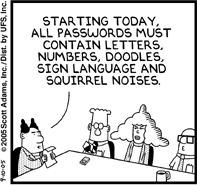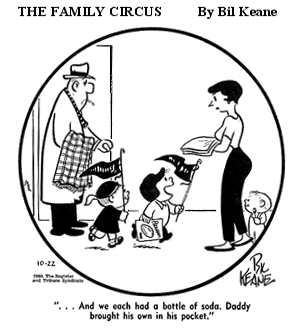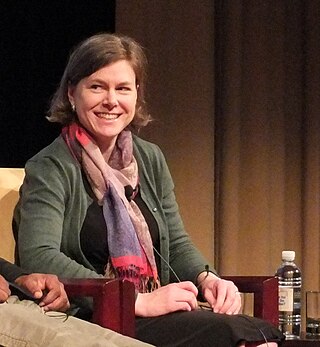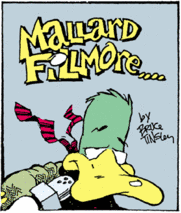Related Research Articles

A cartoon is a type of visual art that is typically drawn, frequently animated, in an unrealistic or semi-realistic style. The specific meaning has evolved, but the modern usage usually refers to either: an image or series of images intended for satire, caricature, or humor; or a motion picture that relies on a sequence of illustrations for its animation. Someone who creates cartoons in the first sense is called a cartoonist, and in the second sense they are usually called an animator.

Dilbert is an American comic strip written and illustrated by Scott Adams, first published on April 16, 1989. It is known for its satirical office humor about a white-collar, micromanaged office with engineer Dilbert as the title character. It has led to dozens of books, an animated television series, a video game, and hundreds of themed merchandise items. Dilbert Future and The Joy of Work are among the best-selling books in the series. In 1997, Adams received the National Cartoonists Society Reuben Award and the Newspaper Comic Strip Award for his work. Dilbert appears online and as of 2013 was published daily in 2,000 newspapers in 65 countries and 25 languages.

The Yellow Kid is an American comic-strip character that appeared from 1895 to 1898 in Joseph Pulitzer's New York World, and later William Randolph Hearst's New York Journal. Created and drawn by Richard F. Outcault in the comic strip Hogan's Alley, the strip was one of the first Sunday supplement comic strips in an American newspaper, although its graphical layout had already been thoroughly established in political and other, purely-for-entertainment cartoons. Outcault's use of word balloons in The Yellow Kid influenced the basic appearance and use of balloons in subsequent newspaper comic strips and comic books.

Peanuts is a syndicated daily and Sunday American comic strip written and illustrated by Charles M. Schulz. The strip's original run extended from 1950 to 2000, continuing in reruns afterward. Peanuts is among the most popular and influential in the history of comic strips, with 17,897 strips published in all, making it "arguably the longest story ever told by one human being". At the time of Schulz's death in 2000, Peanuts ran in over 2,600 newspapers, with a readership of roughly 355 million across 75 countries, and had been translated into 21 languages. It helped to cement the four-panel gag strip as the standard in the United States, and together with its merchandise earned Schulz more than $1 billion. It got a movie adaptation in 2015 by Blue Sky Studios.

Comics are a medium used to express ideas with images, often combined with text or other visual information. It typically takes the form of a sequence of panels of images. Textual devices such as speech balloons, captions, and onomatopoeia can indicate dialogue, narration, sound effects, or other information. There is no consensus among theorists and historians on a definition of comics; some emphasize the combination of images and text, some sequentiality or other image relations, and others historical aspects such as mass reproduction or the use of recurring characters. Cartooning and other forms of illustration are the most common means of image-making in comics. Photo comics is a form that uses photographic images. Common forms include comic strips, editorial and gag cartoons, and comic books. Since the late 20th century, bound volumes such as graphic novels, comic albums, and tankōbon have become increasingly common, along with webcomics as well as scientific/medical comics.

Mutt and Jeff is a long-running and widely popular American newspaper comic strip created by cartoonist Bud Fisher in 1907 about "two mismatched tinhorns". It is commonly regarded as the first daily comic strip. The concept of a newspaper strip featuring recurring characters in multiple panels on a six-day-a-week schedule had previously been pioneered through the short-lived A. Piker Clerk by Clare Briggs, but it was Mutt and Jeff as the first successful daily comic strip that staked out the direction of the future trend.
Tom the Dancing Bug is a weekly satirical comic strip by cartoonist and political commentator Ruben Bolling that covers mostly US current events from a liberal point of view. Tom the Dancing Bug won the 2002, 2003, 2007, 2008, and 2009 Association of Alternative Newsweeklies Awards for Best Cartoon. The strip was awarded the 2010 Sigma Delta Chi Award for editorial cartooning by the Society of Professional Journalists and best cartoon in the 2018 Robert F. Kennedy Book & Journalism Awards. His work on the strip won Bolling the 2017 Herblock Prize and the 2021 Berryman Award for Editorial Cartoons, and he was a finalist in the Editorial Cartooning category for the 2019 and 2021 Pulitzer Prize.

The Family Circus is a syndicated comic strip created by cartoonist Bil Keane and, since Keane's death in 2011, written, inked and rendered (colored) by his son Jeff Keane. The strip generally uses a single captioned panel with a round border, hence the original name of the series, which was changed following objections from the magazine Family Circle. The series debuted February 29, 1960, and has been in continuous production ever since. According to publisher King Features Syndicate, it is the most widely syndicated cartoon panel in the world, appearing in 1,500 newspapers. Compilations of Family Circus comic strips have sold more than 13 million copies worldwide.

Cathy is an American gag-a-day comic strip, drawn by Cathy Guisewite from 1976 until 2010. The comic follows Cathy, a woman who struggles through the "four basic guilt groups" of life: food, love, family, and work. The strip gently pokes fun at the lives and foibles of modern women. The strip's debut was on November 22, 1976, and it appeared in over 1,400 newspapers at its peak. The strips have been compiled into more than 20 books. Three television specials were also created. Guisewite received the National Cartoonists Society Reuben Award in 1992 for the strip.

Non Sequitur is a comic strip created by Wiley Miller starting February 16, 1992 and syndicated by Andrews McMeel Syndication to over 700 newspapers. It is also published on gocomics.com and distributed via email.

Nemi is a Norwegian comic strip, written and drawn by Lise Myhre. It made its first appearance in 1997 under the title Den svarte siden. At that time, it was a tonally dark cartoon concerning heavy metal subcultures. Over the years, Myhre made the comic generally brighter and more comedic, though still frequently published with strips about serious issues, especially in the larger Saturday panels. The strip was renamed Nemi after its protagonist, a young goth woman.

Jen Sorensen is an American cartoonist and illustrator who creates a weekly comic strip that often focuses on current events from a liberal perspective. Her work has appeared on the websites Daily Kos, Splinter, The Nib, Politico, AlterNet, and Truthout; and has appeared in Ms. Magazine, The Progressive, and The Nation. It also appears in over 20 alternative newsweeklies throughout America. In 2014 she became the first woman to win the Herblock Prize, and in 2017 she was named a Pulitzer Finalist in Editorial Cartooning.
A daily strip is a newspaper comic strip format, appearing on weekdays, Monday through Saturday, as contrasted with a Sunday strip, which typically only appears on Sundays. They typically are smaller, 3–4 grids compared to the full page Sunday strip and are black and white.

A topper in comic strip parlance is a small secondary strip seen along with a larger Sunday strip. In the 1920s and 1930s, leading cartoonists were given full pages in the Sunday comics sections, allowing them to add smaller strips and single-panel cartoons to their page.

Mallard Fillmore is a comic strip written and illustrated by Bruce Tinsley until 2019 and Loren Fishman since 2020. It has been syndicated by King Features Syndicate since June 6, 1994. The strip follows the exploits of its title character, an anthropomorphic green-plumaged duck who works as a politically conservative reporter at fictional television station WFDR in Washington, D.C. Mallard's name is a pun on the name of the 13th president of the United States, Millard Fillmore.

Arlo and Janis is an American gag-a-day comic strip written and drawn by Jimmy Johnson. It is a leisurely paced domestic situation comedy. It was first published in newspapers on July 29, 1985.
Stone Soup is an American newspaper comic strip. It was created by cartoonist Jan Eliot as Sister City, and was renamed after being syndicated by Universal Press Syndicate in 1995. The strip originally ran daily until 2015, when it switched to Sunday strips only before ending in 2020. The strip centers on a single mother named Valerie Stone, and her struggles to raise her daughters Alix and Holly.

Krazy Kat is an American newspaper comic strip, created by cartoonist George Herriman, which ran from 1913 to 1944. It first appeared in the New York Evening Journal, whose owner, William Randolph Hearst, was a major booster for the strip throughout its run. The characters had been introduced previously in a side strip with Herriman's earlier creation, The Dingbat Family, after earlier appearances in the Herriman comic strip Baron Bean. The phrase "Krazy Kat" originated there, said by the mouse by way of describing the cat. Set in a dreamlike portrayal of Herriman's vacation home of Coconino County, Arizona, KrazyKat's mixture of offbeat surrealism, innocent playfulness and poetic, idiosyncratic language has made it a favorite of comics aficionados and art critics for more than 80 years.

Polly and Her Pals is an American comic strip, created by cartoonist Cliff Sterrett, which ran from December 4, 1912, until December 7, 1958. It is regarded as one of the most graphically innovative strips of the 20th century. It debuted as Positive Polly on December 4, 1912, in William Randolph Hearst's newspapers, initially the New York Journal, and was later distributed by King Features Syndicate. The title changed to Polly and Her Pals on January 17, 1913.
Hilary B. Price is an American cartoonist. She is known for creating the comic strip Rhymes with Orange, which is published digitally on her website and in over one hundred newspapers across the United States. At the age of 25 she became the youngest cartoonist to ever be nationally syndicated. She won the Silver Reuben for "Best Newspaper Panel Cartoon" from the National Cartoonists Society four times, in 2007, 2009, 2012, and 2014.
References
- ↑ Yahoo! Picks > Entertainment > Comics and Animation > Comic Strips
- ↑ Norman, Brian (2010). Neo-segregation Narratives: Jim Crow in Post-civil Rights American Literature. University of Georgia Press. p. 164. ISBN 978-0820335971 . Retrieved 13 October 2019.
- ↑ Stein, Harry (Summer 2005). "Laughing at the Left". City-Journal. Retrieved 13 October 2019.
- ↑ WOWIO: eBooks, Comics and Graphic Novels | Books Evolved
- ↑ Anderson, Brian C. (5 February 2013). South Park Conservatives: The Revolt Against Liberal Media Bias. Simon and Schuster. ISBN 978-1621571124 . Retrieved 13 October 2019.
- ↑ Day by Day Cartoon by Chris Muir :: April 12, 2014 Archives Archived April 19, 2014, at the Wayback Machine
- ↑ Day by Day Cartoon by Chris Muir :: July 21, 2007 Archives Archived September 28, 2007, at the Wayback Machine
- ↑ "Day by Day Cartoon by Chris Muir :: November 5, 2007 Archives". Archived from the original on February 1, 2008. Retrieved November 5, 2007.
- ↑ Day by Day Cartoon by Chris Muir :: November 23, 2007 Archives Archived January 20, 2008, at the Wayback Machine
- ↑ "Me,Too. – Day by Day".
- ↑ Day by Day Cartoon by Chris Muir :: July 16, 2007 Archives Archived August 20, 2007, at the Wayback Machine
- 1 2 3 Dean Esmay (30 October 2003). "Interview With Chris Muir". Blogcritics. Archived from the original on 9 October 2015. Retrieved 11 December 2013.
- ↑ Chris Muir (2007-03-07). "Featured Embedded Report: Chris Muir from Iraq". The Long War Journal.